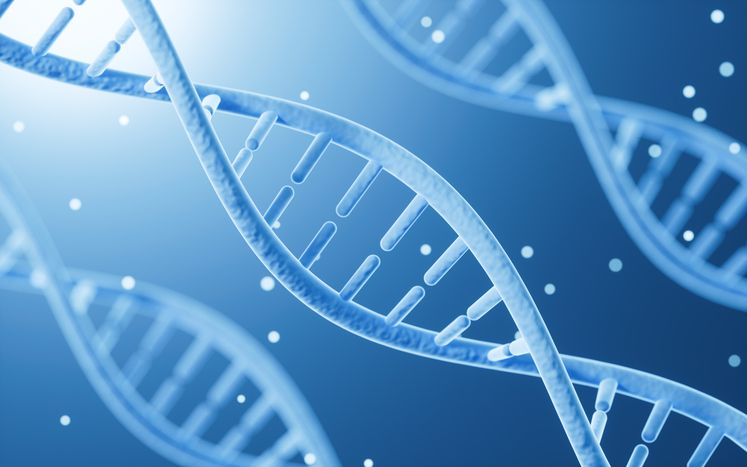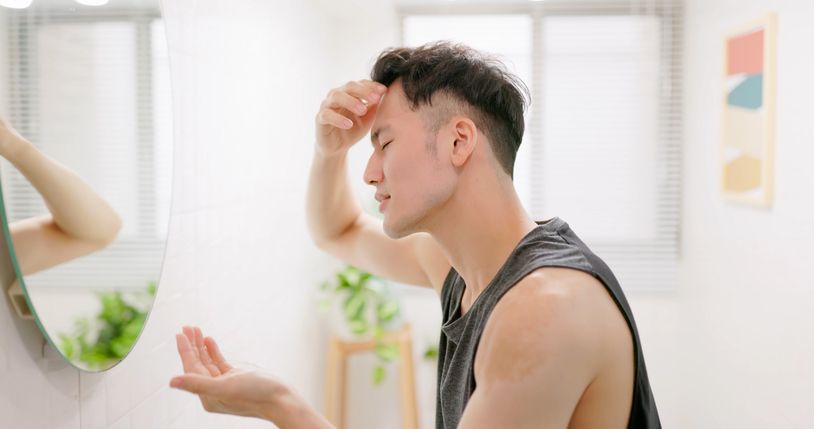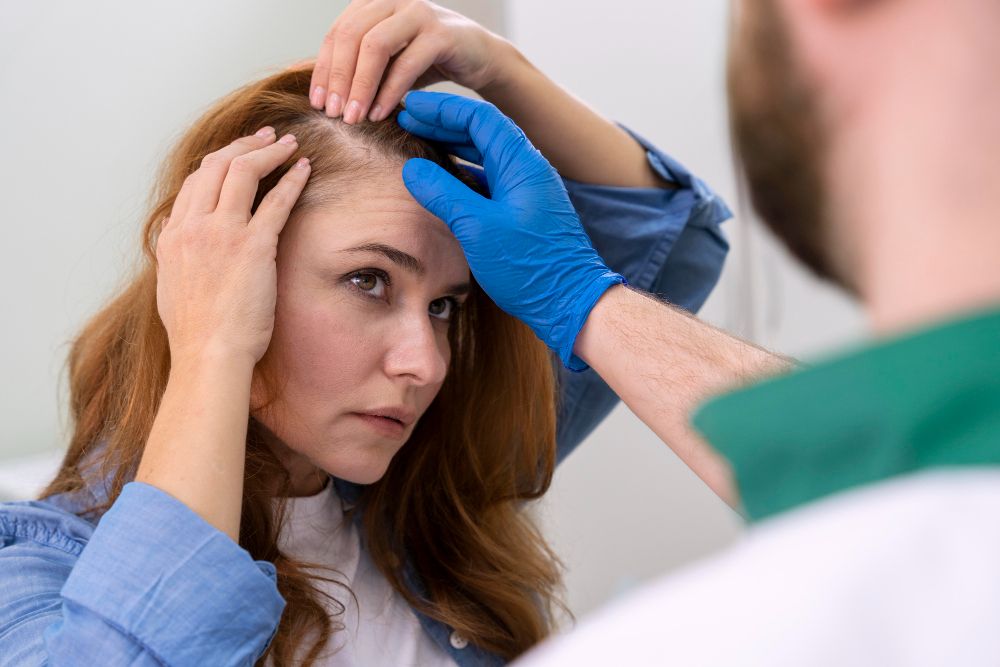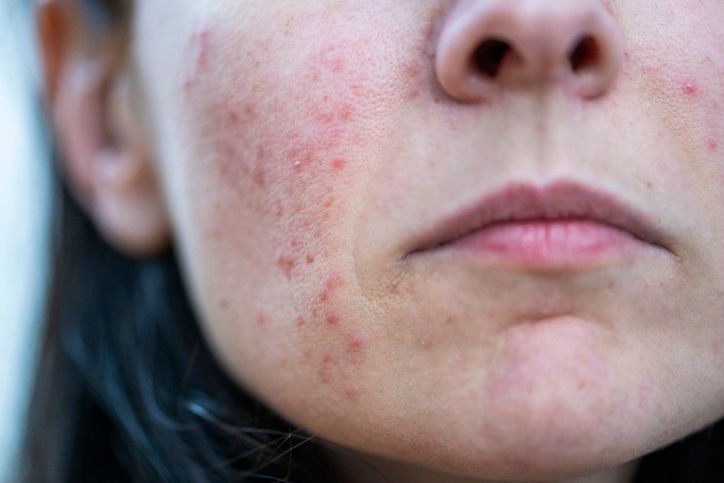
Author: Natalie Ng|Updated: 5 June 2025
There’s a lot of confusion around genetic hair loss. People often say it only comes from your mum’s side, or that wearing hats can make you lose hair. These things get repeated so often, it’s easy to take them as fact while they’re not true. Hair loss linked to your genes, known as androgenetic alopecia, shows up in different ways. It can mean a receding hairline, thinning around the crown, or an overall drop in hair density. It can affect both men and women, and it’s not just about getting older. Whether it’s male pattern baldness or female pattern hair loss, the real causes are usually deeper — like changes in hormones, how your hair follicles react, or family history. We’ll break down the biggest myths people still believe about hereditary hair loss — and what’s actually true. Keep reading to get the facts straight.

Genetic Hair Loss Myth 1: Hair Loss Only Comes From Your Mother’s Side

Both Parents Can Pass On Hair Loss Genes
Many people think hair loss comes only from their mother’s side. That’s not true. Genetic hair loss, also called androgenetic alopecia, can be passed down from either parent.
Your family history plays a big part in how your hair grows, how long the growth phase lasts, and how your hair follicles respond to male hormones. That includes both male pattern hair loss and female pattern baldness. So if you notice hair loss on your father’s side too — like a receding hairline or thinning areas — it matters just as much.
Hair Loss Involves More Than One Gene
Hair loss isn’t linked to a single gene. It involves several genes from both sides of your family. These genes affect how sensitive your scalp hairs are to androgens, the hormones that influence hair growth. If you carry certain gene combinations, your hair follicles may shrink earlier, leading to finer hairs or even complete hair loss over time.
Knowing that both sides of your family can influence hair loss helps you spot early signs — like diffuse thinning or changes in hair density — and start early treatment if needed. Whether it’s male androgenetic alopecia or early onset androgenetic alopecia, getting the facts straight can make it easier to choose the right hair loss treatment.

Genetic Hair Loss Myth 2: Wearing Hats Causes Balding

Hats Don’t Affect Hair Follicles or Cause Genetic Hair Loss
The idea that wearing hats leads to balding has been around for years, but there’s no truth to it. You can wear your favorite cap, beanie, or bucket hat without worrying about losing hair because of it.
Your hair follicles don’t stop working just because they’re covered. Genetic hair loss, or androgenetic alopecia, is mostly influenced by your hormones and genes — not your choice of headwear. The hormone DHT (dihydrotestosterone) affects how your follicles behave over time, and that’s what plays the biggest role in male pattern baldness or female pattern hair loss.
Tight Hats and Traction Alopecia
If your hat is extremely tight and pulling at your hair regularly, it could lead to a separate condition called traction alopecia. That’s a temporary type of hair loss caused by constant tension — not genetics. But for most people, wearing a properly fitting hat won’t cause any damage at all. It won’t interfere with your hair growth cycle or reduce hair density.
As long as your hat fits comfortably and doesn’t tug at your scalp hairs, it has no effect on hereditary patterned baldness. Wearing hats is safe and won’t contribute to further hair loss.
Read More
Book Now to Experience
F8 Hair Regrowth Treatment
1 Minute Self-Registration
Date should not be before minimal date

Genetic Hair Loss Myth 3: Hair Loss Only Affects Older People

Genetic Hair Loss Can Start at a Young Age
Many assume that hair loss only begins later in life, but androgenetic alopecia can start much earlier. Genetic factors and hormonal changes influence when pattern hair loss begins, not age. Signs of thinning hair or a receding hairline may appear during puberty or early adulthood, long before most expect it.
Hair Loss in Young Adults
Hair loss isn't limited to older adults. In fact, early onset androgenetic alopecia affects a large number of people in their teens and twenties. Hair thinning or bald spots in young adults are often the result of inherited sensitivity to DHT, not aging.
• Around 25% of men begin to lose hair before age 21
• Female pattern hair loss can begin during late teens or early twenties
• Hormonal shifts and stress can speed up genetic shedding
• Early treatment improves long-term outcomes
• Medical treatments like finasteride, minoxidil, or laser therapy are effective for younger people
Early detection allows for better control over the rate of further hair loss and improves the chances of maintaining hair density.
Teenagers Can Develop Androgenetic Alopecia
Some teens begin to notice hair shedding, thinner strands, or patchy hair loss even before adulthood. These early signs often go unrecognized or are mistaken for temporary issues. But if hereditary hair loss runs in the family, it's possible for symptoms to start shortly after puberty.
Changes such as a visible scalp under bright light or a receding frontal hairline may indicate genetic changes already affecting the hair growth cycle. Treatments that target the cause — like hormonal sensitivity — can be considered after a proper evaluation by a dermatologist or trichologist.
Age Is Not the Deciding Factor
The idea that hair loss only comes with age is incorrect. Some people experience complete hair loss over time, while others retain most of their hair well into old age. The difference often lies in genetic factors, hormonal responses, and the timing of early changes.
• Some notice thinning at 20, others not until 50
• Loss may happen gradually or progress quickly
• Family history and hormone levels guide pattern and onset
• Environmental and health factors can affect the timeline
• Ethnic background can also play a role in how hair loss occurs

Genetic Hair Loss Myth 4: Stress Is the Main Trigger for Genetic Hair Loss

Genetic Hair Loss Is Driven by Hormones and DNA
While many worry that stress is behind their hair loss, pattern baldness is mostly controlled by inherited genes and hormones. Androgenetic alopecia — the most common cause of male pattern baldness and female pattern hair loss — develops when the hormone DHT (dihydrotestosterone) affects genetically sensitive hair follicles.
These follicles slowly shrink, which shortens the growth phase of the hair cycle. As a result, hairs become finer over time and may stop growing completely. This process happens regardless of daily stress levels.
Stress-Related Shedding Happens Differently
High stress can lead to a different type of temporary hair loss known as telogen effluvium. This condition causes diffuse thinning across the scalp and usually corrects itself when the stress passes. It does not cause permanent changes in hair follicles or influence hereditary hair loss patterns.
Pattern hair loss, on the other hand, tends to follow a clear path: a receding hairline, crown thinning, or general hair density loss depending on gender. This continues over time and is unaffected by emotional or physical stress.
Scientific Evidence on Pattern Hair Loss
Research confirms that genetic and hormonal factors are the main influences in androgenetic alopecia. Stress plays a minor role and does not activate the genetic pathway that leads to permanent follicle shrinkage.
Factor
Impact on Hair Loss
Genetics – High (80% determining factor)
Hormones – Major (linked to DHT conversion)
Stress – Minor (triggers temporary shedding only)
Hair follicles affected by DHT gradually shrink, leading to progressive hair loss. While stress can cause hair to fall temporarily, it does not change how androgens stimulate hair growth or affect long-term hair density. Treatments that block DHT or support the hair cycle, such as oral finasteride, red light therapy, or platelet rich plasma injections, are more effective for treating androgenetic hair loss than stress reduction alone.
Book Now to Experience
F8 Hair Regrowth Treatment
1 Minute Self-Registration
Date should not be before minimal date

Genetic Hair Loss Myth 5: Only Men Experience Hereditary Hair Loss

Women Also Experience Pattern Hair Loss
The idea that hereditary hair loss only affects men is false. Both men and women can experience androgenetic alopecia, although the patterns differ. While male pattern baldness often starts with a receding hairline or thinning at the crown, female pattern hair loss usually causes diffuse thinning across the scalp.
Hair thinning in women may begin around menopause, but it can also occur earlier. Hormonal shifts, especially involving androgens, play a role in both male and female cases. The same genetic and hormonal mechanisms influence how hair follicles shrink and produce finer hairs over time.
Gender-Based Differences in Hair Loss Patterns
Although the root cause of hair loss is shared, men and women often show different signs and progressions:
Gender
Common Pattern
Typical Age of Onset
Female – Diffuse loss – Post-menopause
Male – M-pattern recession – Early 20s
Both – Crown thinning – Various ages
Women account for nearly 40% of hair loss cases. Yet, the condition is often underdiagnosed or ignored in female patients due to lingering stereotypes.
Recognising female pattern baldness early can lead to more effective treatment. Whether the concern is patchy hair loss, diffuse thinning, or reduced hair density, treatment options like minoxidil, low-level laser therapy, or platelet rich plasma are suitable for both men and women. Hair restoration isn’t gender-specific — and neither is hereditary hair loss.

Genetic Hair Loss Myth 6: Frequent Hair Washing Accelerates Genetic Balding

Washing Hair Doesn’t Cause Hair Follicles to Shrink
The belief that washing your hair too often causes hair loss isn’t backed by science. Shampooing your hair regularly does not affect the hormones or genetic factors responsible for androgenetic alopecia. Pattern hair loss is caused by how your body responds to DHT, not how often you clean your scalp.
Keeping your scalp clean may even help support healthy hair growth. Removing oil, buildup, and dead skin allows hair follicles to stay clear and function properly. Dirty or clogged follicles may lead to irritation but do not trigger hereditary hair loss.
Hair Washing and Genetic Factors Are Unrelated
Frequent washing — even daily — doesn’t lead to further hair loss if you’re dealing with male or female pattern hair loss. What matters more is using gentle, pH-balanced shampoos that support scalp health without causing dryness or inflammation.
• Genetic hair loss progresses due to DHT sensitivity, not hygiene habits
• Clean follicles allow better oxygen and nutrient flow
• Daily washing doesn’t affect the progression of pattern hair loss
• Mild shampoos help reduce scalp irritation and support the hair growth cycle
• Removing buildup can reduce breakage and improve hair texture
Hair shedding in the shower is normal and usually reflects older strands reaching the end of their growth phase. This natural part of the hair cycle shouldn’t be confused with genetic balding. Washing your hair regularly supports scalp health — and does not influence whether you lose hair due to hereditary reasons.
Book Now to Experience
F8 Hair Regrowth Treatment
1 Minute Self-Registration
Date should not be before minimal date

Genetic Hair Loss Myth 7: Hair Products Can Stop Genetic Hair Loss

Hair Products Can’t Reverse Genetic Hair Loss
Many over-the-counter products claim to stop or reverse genetic hair loss, but none of them can change the way your DNA affects your hair follicles. Androgenetic alopecia is a hereditary condition that occurs deep within the follicle, and no shampoo, serum, or conditioner can reach that level to affect the root cause.
Genetic hair loss is triggered by how your body processes hormones like DHT. This hormone shrinks sensitive follicles over time, leading to finer hairs and eventually complete baldness in some areas. Despite bold marketing claims, topical products simply can’t block this internal process.
DHT and the Limits of Cosmetic Products
Some products advertise “DHT-blocking” ingredients, but they don’t reach the follicle in a way that impacts how androgens stimulate hair growth. They may help improve the look or feel of thinning hair, but they can’t prevent further hair loss caused by genetic factors.
• Genetic hair loss happens at the follicular level due to hormone sensitivity
• Products applied to the scalp can’t penetrate deep enough to affect DHT
• Natural ingredients aren’t a substitute for medical treatments
• No topical cosmetic product can alter inherited traits or delay hair loss patterns
• Effective treatments target hormone pathways or stimulate follicle activity
Instead of spending money on cosmetic fixes that won’t affect the actual cause, focus on medical treatments shown to support hair regrowth and follicle function. These include finasteride treatment, minoxidil, laser therapy, and platelet rich plasma — all of which work by targeting the real mechanisms behind hereditary patterned baldness.

Genetic Hair Loss Myth 8: Genetic Hair Loss Always Starts With a Receding Hairline

Hair Loss Patterns Can Vary From Person to Person
Many assume that hereditary hair loss always begins at the hairline, but this isn’t true for everyone. Androgenetic alopecia can start in different areas of the scalp, depending on your genetics, hormone levels, and how your hair follicles respond to DHT.
Some people notice thinning at the crown. Others experience diffuse thinning across the entire scalp, or see their temple areas recede without any crown involvement. Some may even have a combination of these patterns.
• Diffuse thinning that affects the full scalp evenly
• Thinning at the vertex or crown while the hairline remains unchanged
• Recession at the temples without significant loss elsewhere
• Mixed patterns involving crown and frontal hairline
• General reduction in hair density without visible balding
Monitoring only the frontal hairline is not enough. Hereditary hair loss can show up in different places at different times, and missing early signs on other parts of the scalp may delay treatment. Regular scalp checks and awareness of your family history help detect pattern hair loss before complete hair loss occurs. Starting early with the right treatment options can protect existing hair and stimulate hair regrowth.
Book Now to Experience
F8 Hair Regrowth Treatment
1 Minute Self-Registration
Date should not be before minimal date

Genetic Hair Loss Myth 9: Sun Exposure Worsens Hereditary Hair Loss

UV Rays Don’t Affect Genetic Hair Loss Progression
Many worry that sun exposure might speed up genetic balding, but ultraviolet rays do not cause or worsen hereditary patterned baldness. Androgenetic alopecia is caused by genetic factors and hormonal sensitivity, not by time spent in the sun.
Your DNA determines how your hair follicles react to DHT, the hormone responsible for male androgenetic alopecia and female pattern hair loss. Sunlight doesn’t change this process. Even prolonged sun exposure won’t alter how androgens stimulate hair growth or contribute to further hair loss.
UV Damage and Hair Health
While the sun doesn’t influence genetic hair loss, UV rays can still harm the surface of the hair. Excessive exposure may lead to dryness, breakage, or irritation of the scalp, which affects the appearance of thinning hair — but not the actual pattern or rate of loss.
• Genetic factors control 80% or more of hair loss development
• UV rays affect the outer hair shaft, not the follicle
• Hats help protect your scalp but won’t stop hereditary hair loss
• Sunscreens shield the skin but don’t block hair thinning
• Time outdoors does not interfere with the hormonal process behind pattern baldness
Focusing on treatments that target DHT sensitivity is more effective than avoiding the sun. Still, sun protection supports general hair health. Use leave-in conditioners with UV filters, wear breathable hats, or apply scalp-friendly sunscreen during peak hours. These steps protect existing strands and improve manageability without interfering with the hair growth cycle.

Genetic Hair Loss Myth 10: Hair Transplants Don’t Work for Genetic Balding

Hair Transplants Are Effective for Treating Hereditary Hair Loss
Hair transplantation is one of the most effective treatment options for hereditary hair loss. The myth that it doesn’t work is outdated. Modern techniques allow surgeons to precisely move healthy hair follicles from one part of the scalp to areas affected by male pattern baldness or female pattern hair loss, producing natural-looking, long-lasting results.
Hair transplants work by relocating follicles that are resistant to DHT — usually from the back or sides of the head — to thinning or balding areas. Once transplanted, these hairs grow like normal and are not affected by further hair loss in most cases.
• Follicular Unit Transplantation (FUT) and Follicular Unit Extraction (FUE) are the most common methods
• Individual hair follicles are carefully placed for a natural hairline and improved hair density
• Results typically begin to show between 6 and 9 months after surgery
• Transplanted hairs can be styled and trimmed just like your original hair
• Most patients resume regular activities within 1 to 2 weeks
Hair transplants provide a permanent solution when performed by qualified professionals. They work well for those with stable pattern hair loss and a healthy donor area. As part of a broader hair restoration plan, they can be combined with medical treatments like oral finasteride or platelet rich plasma to support long-term hair regrowth and help prevent further hair loss in untreated areas.

F8 Hair Regrowth Therapy: A Non-Surgical Option for Genetic Hair Loss
Supporting Hair Follicles Without Surgery
Genetic hair loss can be frustrating, especially if you’re not ready for a surgical procedure like a hair transplant. F8 Hair Regrowth Therapy offers an alternative for those dealing with male pattern baldness, female pattern hair loss, or early onset androgenetic alopecia — without the need for incisions or downtime.
F8 targets hereditary patterned baldness by improving blood circulation in the scalp and stimulating dermal papilla cells. These cells play a key role in controlling the hair growth cycle. By strengthening the environment around the follicles, F8 helps reactivate weak scalp hairs and support new hair growth, even in areas showing signs of thinning.
How F8 Enhances Hair Growth
This treatment focuses on restoring the function of hair follicles affected by androgens like DHT. It’s designed to slow further hair loss and promote healthier hair regrowth in both men and women experiencing genetic hair thinning. Over time, users may notice improvements in hair density, thickness, and the strength of individual strands.
• Improves oxygen and nutrient supply to the scalp
• Stimulates follicles that have entered a dormant state
• Supports the hair growth cycle without affecting surrounding skin
• Pairs well with medical treatments like oral finasteride or red light therapy
• Helps manage female pattern baldness and male androgenetic alopecia
F8 can be especially helpful for those who aren’t ideal candidates for hair transplants, such as individuals with diffuse thinning, patchy hair loss, or limited donor areas. Because it works by encouraging natural growth, the results blend in seamlessly with your existing hair.
If you’re noticing thinning areas or want to treat genetic hair loss before it progresses, F8 offers a non-invasive, clinic-based solution worth considering. Book F8 to find out whether this treatment is right for your hair loss pattern and long-term goals.
New Beauty's F8 Hair Regrowth TreatmentBook Now to Experience
F8 Hair Regrowth Treatment
1 Minute Self-Registration
Date should not be before minimal date
FAQ
How do I know if my hair loss is genetic or caused by something else?
Genetic hair loss, also called androgenetic alopecia, usually follows a predictable pattern — such as a receding hairline, crown thinning, or widening part. In contrast, hair loss from medical conditions, poor nutrition, or stress often shows up as diffuse thinning or patchy hair loss across the scalp. A consultation with a dermatologist or trichologist can help identify the type of hair loss by assessing your scalp, family history, and hair growth cycle.
Can hormone imbalances outside of DHT affect hereditary hair loss?
Yes. While DHT is the main hormone linked to male pattern baldness and female pattern hair loss, other hormonal changes can also influence hair thinning. Shifts in estrogen, progesterone, or thyroid hormones may impact hair density and the growth phase of scalp hairs. In women, conditions like polycystic ovary syndrome (PCOS) and menopause are also linked to hormonal hair loss patterns.
Is early treatment more effective for hereditary patterned baldness?
Starting treatment early often leads to better outcomes. Once hair follicles shrink too much or become inactive, it's harder to stimulate hair regrowth. Treatments like oral finasteride, minoxidil, laser therapy, or platelet rich plasma are more effective when used in the early stages of male androgenetic alopecia or female pattern baldness. Early intervention can help preserve hair length, prevent further thinning, and maintain healthy hair density.
Can a poor diet influence genetic hair loss?
While diet doesn't cause hereditary hair loss, a lack of nutrients can make the condition worse. Hair growth depends on a balanced diet rich in protein, iron, zinc, and vitamins like B12 and D. Without these, hair follicles may weaken, and thinning can become more noticeable. Supporting your treatment plan with proper nutrition may improve results and support overall hair health.
Is there a link between facial hair growth and scalp hair loss in men?
Yes, male hormones that influence facial hair — like androgens — also affect scalp hairs. In men with male pattern hair loss, androgens stimulate facial hair growth but shrink scalp follicles. This explains why men with a full beard can still experience complete baldness. The sensitivity of scalp hair follicles to DHT, not the level of testosterone itself, is the reason genetic hair loss occurs on the scalp but not the face.
Recommended Articles
COPYRIGHT© NEW BEAUTY MANAGEMENT LIMITED 2025. ALL RIGHT RESERVED.




